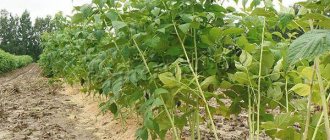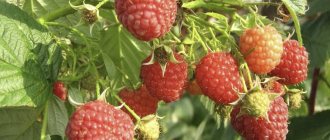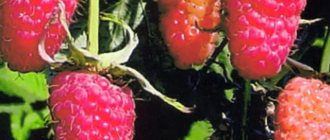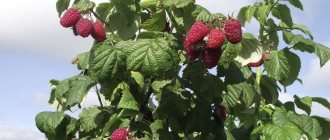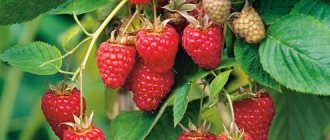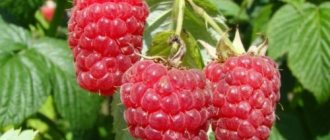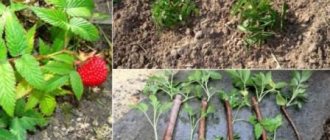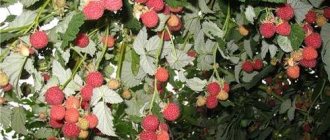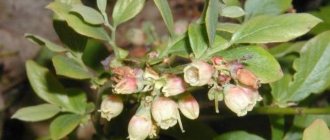Description of the raspberry variety Terenty
The raspberry bush is short, about 120 cm, and forms replacement shoots well; there are 8–10 of them on the plant. The standard type of bush is compact and does not take up much space. The stems are erect and do not fall apart under the weight of the berries. Visually, the raspberry bush resembles a short tree.
The variety is highly productive; fruit buds are located along the entire length of the shoots, each of them forms a cluster. Raspberries are grown in private plots; the variety is not suitable for industrial production. Raspberries are not suitable for storage and transportation. Overripe berries lose their taste and presentation. The distribution area of the culture is throughout the entire territory of Russia, except for the zone of risky farming. The variety is especially popular in the Moscow region and the European zone.
Description of raspberry "Terenty":
- The raspberry bush consists of 8 one-year-old trunks, strong, woody, and erect. The top of the shoot and its base are the same diameter, there is no narrowing upward, so the stems do not bend. The color of the bark is dark brown, the surface is smooth, the waxy coating is insignificant. A special feature of the variety is the absence of thorns on the shoots.
- The color of the young shoots is light green, the shoots grow quickly, by autumn they reach the height of the bush and change color to light brown, there are no thorns.
- The foliage is intense, the leaf plate is medium in size, the surface is rich green, corrugated. The lower part is light, densely pubescent. The edges are serrated and the top is pointed.
- The fruit buds on the stem are densely located, each of them forms a powerful long fruit cluster for the next season. It blooms profusely, with beige flowers that are 100% set. The density of the bunch is up to 30 berries. The fruit branches are thick and strong and do not require fixation to a support.
- The root system is strong, has grown in breadth, and produces few young shoots, about 4 young plants around the mother bush. This is enough for growing raspberries.
Description of Terenty raspberries:
- the fruits are large, larger on the first clusters than on the last ones, weight 6–15 g:
- cone-shaped with a rounded bottom, drupes arranged tightly, without lint on the surface;
- raspberry color is bright burgundy with gloss;
- The pulp has a delicate consistency and contains many small seeds.
Attention! It is recommended to remove Terenty raspberries from the bush when the berries reach biological ripeness. Ripe fruits on the mother plant become soft and may become covered with mold.
Raspberry "Tatiana"
Raspberry "Tatyana" is a non-repairing variety of large-fruited raspberry. The variety bears fruit longer than other non-remontant varieties, so it is often mistakenly classified as remontant. But the “Tatyana” raspberry is unique precisely in that it can exhibit weak remontancy, but the variety is not cut for the winter. At the same time, the plant itself produces about 12 replacement shoots, that is, the bush will be neat and compact. Also a pleasant feature of the variety is its very weak thorniness.
Description of the raspberry variety "Tatyana".
The Tatyana variety has a medium-early ripening period, fruiting occurs from early July to August. Typically, harvesting consists of 5-6 stages. One bush can produce about 10 kg of berries. Even after ripening, the fruits do not fall to the ground, and their removal occurs easily, without effort. The weight of one fruit is from 12 to 20 g. The pulp is dense, the surface of the berry looks lumpy. Ripe fruits acquire a light red color and become velvety to the touch. The seeds do not reach large sizes, remaining small and imperceptible when eaten.
The berries have a wonderful sweet taste, juicy, the berry pulp is melting. The aroma is delicate, unobtrusive, with a long trail of flavor. The berries are also suitable for canning, both for compotes and jam. The variety behaves well in freezing.
Raspberries “Tatyana” can withstand frosts down to -30°C, but its roots are afraid of icing, so it is advisable to cover these raspberries for the winter, especially in regions with harsh but thawed winters. Sawdust, pine needles, and covering material are suitable for this purpose. The variety has immunity against aphids, which often transmit viral diseases. Pride of Russia is not afraid of root rot and major fungal diseases.
Advantages of the Tatyana variety.
- Rich taste and pleasant aroma.
- Transportability.
- Creation of many shoots for replacement, so that the bush can be quickly propagated if desired.
- High yield, which allows not only to provide seven berries and products from them for the whole year, but also to sell the surplus.
- Resistance to fungal, viral diseases and common pests (raspberries cope well with aphids).
- Frost resistance.
Features of planting and care.
Planting seedlings of the Tatyana raspberry variety can be done both in winter and autumn. Seedlings with a closed root system can be planted in summer. The entire process of planting seedlings consists of the following activities:
Using a hand shovel and a garden fork, holes measuring 40 x 40 x 40 cm are dug. In a row, the distance between raspberry plants should be about 1.2 m. It is better to make spacious row spacing with a width of at least 1.5 m. Such planting parameters allow seedlings to obtain good lighting and prevent overgrowing of row spacing.
A very important technique is to apply fertilizers to planting holes. 4–4.5 kg are added to each planting hole. rotted manure, 45–50 g of superphosphate and 20–25 g of potassium chloride. After this fertilizer you need to mix and moisten 10–13 liters. water.
After waiting for the moisture to be absorbed, you need to immediately begin planting the seedling. To do this, place it in the middle of the hole, and after carefully straightening the roots, begin to fill the hole with loose, fertile soil.
The soil around the seedling is compacted and, after making a furrow, watered with 10–15 liters of water.
It is necessary to weed the planted raspberries at least once a week. In this case, the processing depth should be from 3 to 5 cm
To ensure maximum yield, it is very important to prevent soil cracking and weeds from taking root.
Characteristics of the variety
The non-remontant raspberry variety “Terenty” is valued for its large berries and external characteristics. It is difficult to call the variety unpretentious. In order to obtain the desired amount of harvest, it is necessary to comply with agrotechnical rules.
Drought resistance, frost resistance
The berry crop is grown in Siberia and the Urals, this is an indicator of the frost resistance of the Terenty raspberry. The variety can withstand temperatures down to -240 C; when it drops, the root system freezes and the plant may die. To avoid loss of the bush, in temperate climates, raspberries are completely insulated. Where climatic conditions are milder, mulch is sufficient.
The drought resistance of the raspberry variety is average. Watering must be carried out constantly. Lack of moisture will stop the growing season. Excess water will cause root rot. Therefore, it is necessary to determine the optimal amount of watering in accordance with weather conditions.
Productivity and fruiting
The culture belongs to the mid-early varieties; according to reviews, “Terenty” raspberries in the Middle Zone ripen at the end of July, berry picking continues until the end of August. Raspberries with a high concentration of glucose, sweet without acid, with a pronounced aroma. Ripe fruits are poorly attached to the stalk and are prone to shedding.
The standard type does not take up much space. The crown is compact and not spreading. For 1 sq. m place three plants. On average, 6 kg of berries are harvested from one bush from 1 m2 to 20 kg. If the conditions of agricultural technology are met (fertilizing, watering, a sufficient amount of ultraviolet radiation), fruiting can be 25 kg.
Area of application of fruits
Raspberry berries "Terenty" for universal use. Home-grown raspberries are used to make compote, juice, jam, marmalade, preserves. The latest harvest is stored for a long time without losing its gastronomic characteristics in the freezer. Due to their biological composition and taste, raspberries are consumed fresh. The variety is unsuitable for commercial cultivation due to poor transportability.
Resistance to diseases and pests
The third generation selection raspberry “Terenty” inherited immunity from a number of infections from its parent varieties. A type of rot caused by high humidity can become a problem; bacteria affect not only the root system, but also the fruits. Among the pests found on raspberries are stem gall midges and spider mites.
Advantages and disadvantages of the variety
According to reviews, large-fruited raspberries “Terenty” have positive characteristics, which include:
- high productivity;
- large mass of fruits;
- excellent gastronomic score;
- the bush is compact, does not fall apart;
- absence of thorns;
- frost-resistant, can be grown over most of the Russian Federation;
- resistant to infection and parasites.
The disadvantage of this variety is its demands on soil composition and irrigation. Raspberries are prone to falling and are not stored or transported.
Advice! To prevent raspberries from stretching upward, the crop is placed in a well-lit area; the variety does not tolerate shade.
Harvest and storage
You can harvest Terenty raspberries in the second half of July, as the berries ripen at the same time. At one time you can get a sufficient amount of fruit for processing.
Read about the benefits and harms of raspberry jam for the body.
The need for immediate consumption or processing of berries is due to their poor preservation and the impossibility of transportation due to the delicate consistency of the berries. Fresh raspberries should be stored in the refrigerator at a temperature from +2°C to +5°C, maintaining a humidity level of 90%. But it is not possible to preserve the freshness of fruits for more than 4 days.
Terenty raspberries are ideal for growing in temperate climates, where proper conditions can be provided to obtain high yields. In order to collect high-quality, large fruits, you should follow the specifics of agricultural technology for standard raspberries and carry out basic agrotechnical manipulations in a timely manner.
Planting and caring for raspberries Terenty
For normal vegetation and fruiting, Terenty raspberries are provided with the required conditions. Raspberries are planted at the recommended time, on fertile soils. Select good quality planting material and follow care recommendations.
Recommended timing
Raspberry seedlings "Terenty" are placed in a permanent plot in early spring, when night frosts stop and the soil warms up. In the Moscow region, the approximate time is the first half of April. Autumn planting is done two weeks before the onset of frost, during which time the raspberry root system adapts and takes root. Work is carried out in mid-October. The time is determined arbitrarily; each climate zone has its own planting dates.
Choosing a suitable location
A prerequisite for this raspberry variety is the absence of shade. The plant is light-loving, tolerates direct sunlight well, and does not like drafts. The bed is planned on the south side, protected from the north wind. The preferred soil for raspberries is loam or black soil. The site is determined in a place where there is no groundwater. It is not recommended to plant the variety in lowlands, where there is constant dampness and shade.
Selection and preparation of planting material
“Terenty” raspberries are propagated from seedlings purchased from a nursery or young root shoots. In order for planting material to produce a healthy plant, the seedling must meet certain requirements:
- height about 15 cm;
- stem diameter 1.5 cm, smooth coating without damage;
- a raspberry seedling consists of at least 3 equal shoots;
- the root system is well developed, 20 cm long, without dry fragments.
The presence of viable fruit buds on the stems is mandatory.
Landing algorithm
There are two ways to plant raspberries: in a trench 55 cm wide, 40 cm deep, or in holes. The sequence of actions for planting raspberries “Terenty” in a hole:
- They dig a hole with the same parameters as a trench.
- 2 parts of humus, 1 part of turf soil, 100 g of complex fertilizer are poured onto the bottom.
- The root system of raspberry seedlings is dipped for 2 hours in a solution that stimulates growth.
- The raspberries are placed in the center, distributing the roots evenly.
- The plant is deepened by 25 cm, covered with soil, and watered with water at room temperature.
- The root circle is mulched with compost or peat.
Optimal timing for planting raspberries depending on the time of year
Despite the fact that raspberries can be planted in both spring and autumn, their planting has time limits. If you love raspberries and want to grow a large and flowering raspberry tree in your garden, then you need to determine the optimal planting time.
in spring
In general, the planting procedure in spring and autumn does not change its technology much; the preparation of the soil and planting material changes radically.
If you decide to plant raspberries in the spring, then you need to choose a time when the air temperature begins to rise. Most often, planting is carried out in mid-March, but the date may shift. With the right timing, raspberries will quickly take root and begin to grow.
Soil preparation must be approached responsibly; it is necessary to dig up the soil and remove all weeds. You also need to apply mineral fertilizers.
Do not forget that the distance between plants should be large enough, at least 50 cm.
Also make sure that the soil is not too dry. If there is no rain for a long time, water the raspberries yourself.
Every gardener knows that the most accurate sowing dates can only be determined using the lunar calendar. It shows the days on which it is best to sow a particular plant, raspberries are no exception. The best dates for sowing raspberries in 2020:
- March – 26-29;
- April – 11-15, 24-26;
- May – 2-10.
Using the lunar calendar, you can also determine the worst days on which raspberries should absolutely not be planted. The worst days for sowing raspberries in 2021:
- March – 9-11, 19-21, 24;
- April – 5-9, 16-18, 23;
- May – 13, 14, 22;
- June – 9-11, 21-24.
in autumn
Remember, if you plant raspberries in the fall, they will overwinter in open ground. To prevent the plant from dying, the preparation of the soil and site must be treated with special care.
Preparations for planting raspberries in the fall should begin as early as possible, about a month or a month and a half in advance.
First of all, you need to thoroughly dig up the soil and look at its condition. If you have been applying mineral fertilizers to this particular area for several years, then you do not need to prepare the soil in any way.
But, if you have never touched this area, then you need to add several fertilizers to it, namely rotted manure, superphosphate and potassium sulfate. Per square meter of area there should be approximately 1-2 buckets of the first component, 300-400 grams of the second and 100-200 grams of the third
This super-nutritious dressing helps to saturate the soil with nutrients as much as possible, this is especially important when planting in the fall.
If there is a lot of peat on your site, then add washed river sand to the dug soil. There should be at least 4 buckets per square meter.
The last days of September are the most optimal time for planting seedlings. At this time there are not yet strong night frosts, and in general the air temperature is not yet very low.
In spring they begin rapid growth and development.
The most optimal days for sowing raspberries in the autumn:
- October – 17, 19, 20, 23-29;
- November – 15, 16, 19-22, 24-25.
Also, do not forget about the peculiarities of climatic conditions in different regions of the country. First of all, you should focus on what your weather is like.
Aftercare
Agricultural technology for Terenty raspberries is no different from caring for any variety of crop. For good growing season and stable fruiting, it is recommended to follow a number of rules:
- Raspberries are pruned twice - in spring and autumn. In the first case, frozen branches are removed, weak ones are cut off, with the expectation that 8 or 10 strong shoots with developed fruit buds will remain to form a bush. In autumn, last year's stems are removed.
- Raspberries are fertilized with organic matter at the beginning of the growing season, with phosphate fertilizers during flowering, and with potassium-containing products during the ripening period.
- Raspberry "Terenty" is demanding when it comes to watering. Drying out the soil, as well as excess moisture, is undesirable for the plant.
Raspberries require shelter for the winter; the stems are bent to the ground and insulated with snow or a special covering material. Pre-mulch the root with sawdust or dry leaves.
Landing Features
In order for raspberries to grow smoothly on your site, you should carefully study the planting rules, choice of location and optimal conditions.
Deadlines
Raspberries can be planted in spring and summer. But at this time she spends a lot of energy on rooting. Therefore, the best landing period is September or October. When planted 20–30 days before the onset of stable frosts, it will have time to take root and prepare for wintering.
Read more about the advantages of planting raspberries in autumn.
Choosing a suitable location
The bushes love sunny areas protected from winds. The ideal place is considered to be adjacent to the house or buildings, so that the raspberry tree is protected from drafts all year round. You should not plant raspberries in lowlands, where there is a high risk of stagnation of moisture and cold air. The aquifer should not be closer than 1.5 m to the surface of the planting soil. Otherwise, the roots may begin to rot.
Planting in areas where potatoes, tomatoes or eggplants grew is prohibited. The root system of the dessert berry secretes special substances that cause soil fatigue. Therefore, gardeners are recommended to plant bushes in the place of the previous ones only after 5–7 years.
Important! Raspberries of this variety bear fruit only in well-lit areas. But you can’t plant it too close to buildings.
After all, any shadow threatens to reduce the yield and deteriorate the quality of the berries themselves.
Selection and preparation of planting material
Only high-quality seedlings can produce a good harvest.
When buying them in nurseries or at markets, it is important to follow the rules for choosing a healthy plant:
- Developed fibrous root system, without mold.
- Flexible and clean (no signs of lichen or mold) branches 8–10 mm thick.
- It is recommended to purchase two-year-old bushes in containers with a mature root system.
It is important to properly prepare the planting material. Further rooting and active growth of raspberries depends on this
Recommendations from experienced gardeners are as follows:
- Immediately after purchase, it is better to immerse the plant in purified water, so it will be saturated with the required amount of moisture.
- Damaged and rotten roots must be removed from the roots.
- Trim the tops so that there are 3-4 pairs of leaves left on them.
- In order to prevent fungal diseases, it is recommended to treat seedlings with a growth stimulator or fungicide.
If the raspberries were bought on the eve of frost, it is already too late to plant them in a permanent place of growth, but it is better to bury them in the garden: make a groove 15 cm deep with a sloping edge, on which the plant is placed and covered with leaves and soil. This way the bush can safely overwinter.
Planting scheme
If clay predominates on the site, then it is worth taking care to improve the growing conditions. For example, you can dilute the soil with sand (1 bucket/m²). Sandy areas need fertilizing and watering. Otherwise, cultivation will not give the desired harvest.
Did you know? According to legend, the first raspberry garden was planted by the great ruler and founder of Moscow, Yuri Dolgoruky. The raspberry patch was so large that there were wild animals in it, including bears.
Planting methods are as follows:
- Planting in rows. The row spacing is 150–200 cm, and the distance between bushes is 0.5–1.0 m.
- Tape method. Pits measuring 50x45 cm are prepared. With this planting, the bushes are placed in 2-3 rows with a distance between them of 60–90 cm. The free space between the ribbons is 1.5–1.8 m.
- Bush planting. Trenches measuring 60x45 cm are dug. 95–100 cm are left between them. 2 bushes are placed in one hole. The distance between bushes may vary depending on the size of the plants.
After planting, it is important to sprinkle the seedlings with soil, pressing them tightly to the roots. Then water the plants with 5–7 liters of water
If it is not possible to devote time to daily watering, then it is better to make a mulch layer using humus, peat or sawdust. This will help retain moisture.
Read more about how to mulch raspberries.
Reproduction methods
The “Terenty” raspberry variety is bred from seedlings that are purchased from nurseries with a positive reputation located in the region of future planting. Planting material will be of good quality and adapted to climatic conditions.
You can get Terenty raspberry seedlings yourself. The root system produces about 5 young shoots during the growing season. In the fall, it is dug up, placed in a container with sand, and put away for wintering in a cool, dark room. In the spring they are assigned to a permanent bed.
Reviews from gardeners
Marina, 48 years old, Kirov
It took us a long time to choose varieties for our raspberry garden at the dacha. As a result, we settled on Terenty raspberries based on the description of the variety, photos and reviews. The seedlings took root well and began to grow. The taste of raspberries is excellent. The berries are sold and used at home. The jam turns out to be especially tasty.
Vladimir, 59 years old, Volgograd
The Terenty raspberry variety is considered one of the best in their area. First I saw it at a neighbor’s place and liked the appearance and taste of the fruit. The variety does not get sick and responds positively to organic fertilizers. I definitely trim the bushes to get a big harvest.
Elizaveta, 25 years old, Krasnodar
We purchased Terenty raspberries from a nursery to plant at our parents’ dacha. We previously selected Terenty raspberries according to the description and photo. The variety attracted me with its large berries and unpretentiousness. We regularly water the raspberry tree during drought, add wood ash and compost. Next year we plan to increase the area for planting it. Children really like the berries and are suitable for homemade preparations.
Diseases and pests, methods of control and prevention
According to gardeners, the raspberry variety “Terenty” needs to be sprayed with Bordeaux mixture against infectious diseases in the spring; when the crop begins to bloom, it is treated with biologically active agents. In the fall, the soil is dug up and ash is added; this measure allows you to destroy parasite larvae and fungal spores.
When raspberries are affected by stem gall midges, deformed shoots are cut off and removed from the site. The plant is treated with Alatar. If rot appears, adjust the watering regime, apply potassium fertilizer, and loosen the soil to allow oxygen to enter.
History of selection
The raspberry variety Terenty became known to the scientific world in 1994 thanks to the breeding work of Professor V.V. Kichina, who conducted biological research at the Moscow Institute of Horticulture and Nursery Growing. To create the variety, cross-pollination of large-fruited second-generation raspberry varieties - Patricia and Tarusa - was carried out.
The parent variety Tarusa is a standard variety, therefore, during experimental cultivation, hybrid seedlings also showed an interesting standard type shape . The plant received variety status and its name in 1998.
Did you know? The first person to discover wild raspberries was Pliny, an ancient Roman polymath writer. He tried the wild berry on the island of Crete and soon took out a seedling for cultivation in European territories.
The best and large-fruited varieties for Siberia
Siberia is characterized by a significant increase in continental climate and repeated returns of cold weather in the spring, which requires the selection of only the most resistant to adverse weather conditions berry crop varieties. Of particular interest from the point of view of home gardening are large-fruited raspberries of remontant varieties.
| Variety name | Botanical description | Characteristics of the berry | Varietal advantages and disadvantages |
| "Indian summer" | The bushes are spreading, medium in size, 1.8-2 m high, with strongly branching and erect shoots, each of which has approximately 14–17 laterals | Dark raspberry, good taste, with an unexpressed aroma and delicate sweet and sour pulp | Late remontant variety with frost resistance down to -24°C and a yield of 3.0-3.5 kg per plant |
| "Monomakh's Cap" | A bush up to one and a half meters high, consisting of five powerful, drooping shoots with thorns at the base | Very large in size and deep purple in color, with a pronounced aroma | Late remontant variety with frost resistance down to -25°C and a yield of 4.0-4.2 kg per plant |
| "Hercules" | Plant 1.5-2 m high, slightly spreading with slight shoot formation and powerful shoots | Large, pleasant sweet and sour taste, with a pronounced aroma, transportable | Medium remontant variety with frost resistance down to -23°C and a yield of 3 kg per plant |
| "Bryansk miracle" | The bush is powerful and slightly spreading, with thick spiny shoots and a waxy coating on the side branches | Very large in size, elongated-conical, with uniform red drupes, sweet and sour | A mid-late remontant variety with frost resistance down to -24°C and a yield of 2.5-3.0 kg per plant |
| "Unattainable" | Medium vigor, up to one and a half meters high, with well-developed replacement shoots and large leaves | Above average in size, bright scarlet color, with a pleasant aroma and delicate taste | An early remontant variety with frost resistance down to -24°C and a yield of 3.0 kg per plant |
| "Chief" | The plant is low, not prone to lodging, with weak thorniness and a small amount of shoots | Large size, dark red color, round shape, excellent taste | A medium remontant variety with frost resistance down to -23°C and a yield of 2.5-3.2 kg per plant |
| "Kalashnik" | Tall bush up to 2 m tall, spreading and powerful, with good shoot formation ability | Round or blunt conical shape, dark red color, sweet, with a shiny surface | A mid-late remontant variety with frost resistance down to -24°C and a yield of 2.5-3.0 kg per plant |
| "Gift of Siberia" | Spreading, powerful and strong plant up to 2.8 m high with short thorns along the entire length of the shoot | Bright cream color, with slight pubescence, hemispherical attractive shape | Medium remontant variety with frost resistance down to -23°C and a yield of 4.3 kg per plant |
